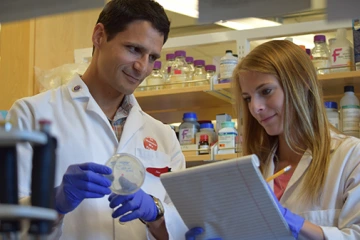Human Papillomavirus is Not a Defeated Virus
What lacks a brain but has the ability to swiftly avoid setting off our body’s intruder detectors, bringing its own blueprints into our cells to make more of itself, and in some cases, cause cancer? Human papillomavirus.

Human papillomavirus (HPV) is the most commonly sexually transmitted virus, and it is estimated that 80 percent of people will be infected by HPV in their lifetimes. HPV is spread by skin-to-skin contact and can infect various parts of the body, such as the hands, feet, mouth, throat and anogenital regions.
Many HPV infections show no signs or symptoms, and are by the body’s immune system in about two years. In a number of cases, HPV infections can manifest as non-cancerous warts, also known as papillomas. However, in fewer than 5 percent of cases, HPV infections can lead to cancer, although it can take more than 20 years for the disease to develop. HPV infections contribute to 5 percent of all cancers worldwide: more than 90 percent of anal and cervical cancers, 70 percent of vaginal and vulvar cancers, 60 percent of penile cancers, and 70 percent of all head and neck cancers are linked to HPV.

The HPV vaccine was only recently approved for use in boys, as emerging research has shown that HPV infections can be attributed to a wide range of head and neck and anogenital cancers in men.
Further, the vaccination was only recently approved for use in boys, as emerging research has shown that HPV infections can be attributed to a wide range of head and neck and anogenital cancers in men. Further, condoms are not effective in preventing HPV infection, as the virus is spread through skin-to-skin contact, as opposed to bodily fluids. Despite the availability of vaccines, the prevalence of HPV-related cancers is still on the rise.

The Campos Lab at the University of Arizona research focuses on better understanding the infectious process of the human papillomavirus (HPV): how it efficiently enters our cells and brings instructions to make more of itself.
Our research focuses on better understanding the infectious process of the virus: how it efficiently enters our cells and brings instructions to make more of itself. We have found that the means by which HPV enters our bodies and makes its way to the cell’s nucleus, or control center, is incredibly unique and not shared by any other virus. Upon infection, the virus hides within a special compartment of the cell until the cell is ready to divide. Only when one cells splits into two does the virus come out of hiding to successfully complete infection. We believe the reason for this unique method of infection may be due to the pressures of viral evolution to avoid setting off our body’s alarm systems.

Upon infection, the human papillomavirus (HPV) hides within a special compartment of the cell until the cell is ready to divide. Only when one cells splits into two does the virus come out of hiding to successfully complete infection.
By better understanding how the virus avoids setting off our body’s alarm system, we will be able to understand how infections are established, persist for years and eventually lead to cancer. We hope the findings from our research may help other scientists find a way to heal HPV infections before they have a chance to cause cancer. I hope that the discoveries I make using tiny cells and fake viruses lead to a reduction in the number of HPV-related cancers in both men and women.
About the Author
Brittany L. Forte, BSc, is a fourth-year Cancer Biology PhD candidate at the University of Arizona. She received a Bachelor of Science degree from the University of Arizona in 2015, studying biochemistry, molecular and cellular biology and mathematics. Forte’s dissertation research focuses on the interaction between human papillomavirus and the innate immune system. She hopes to connect the virus immunoevasive tactics to viral persistence and carcinogenesis.

